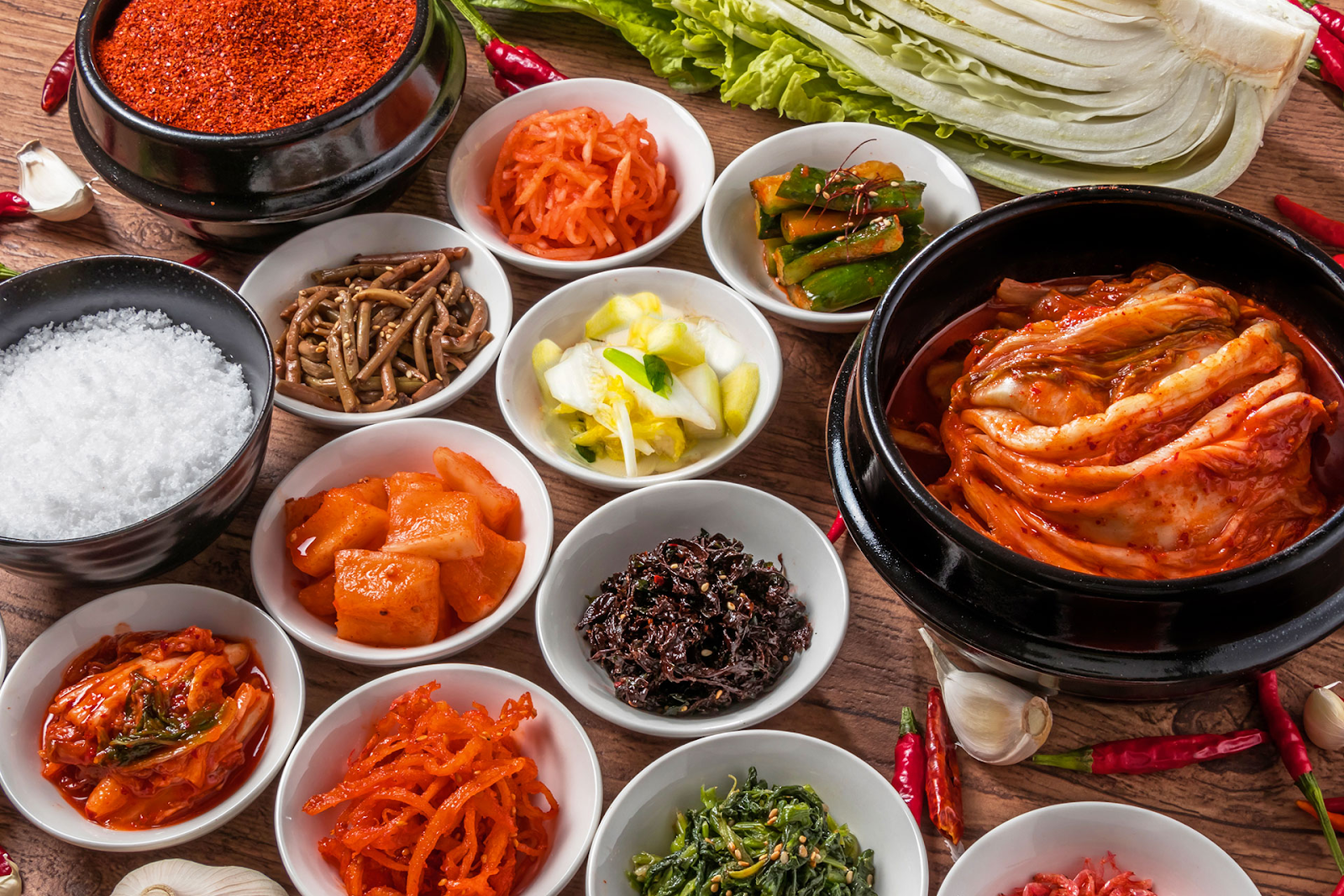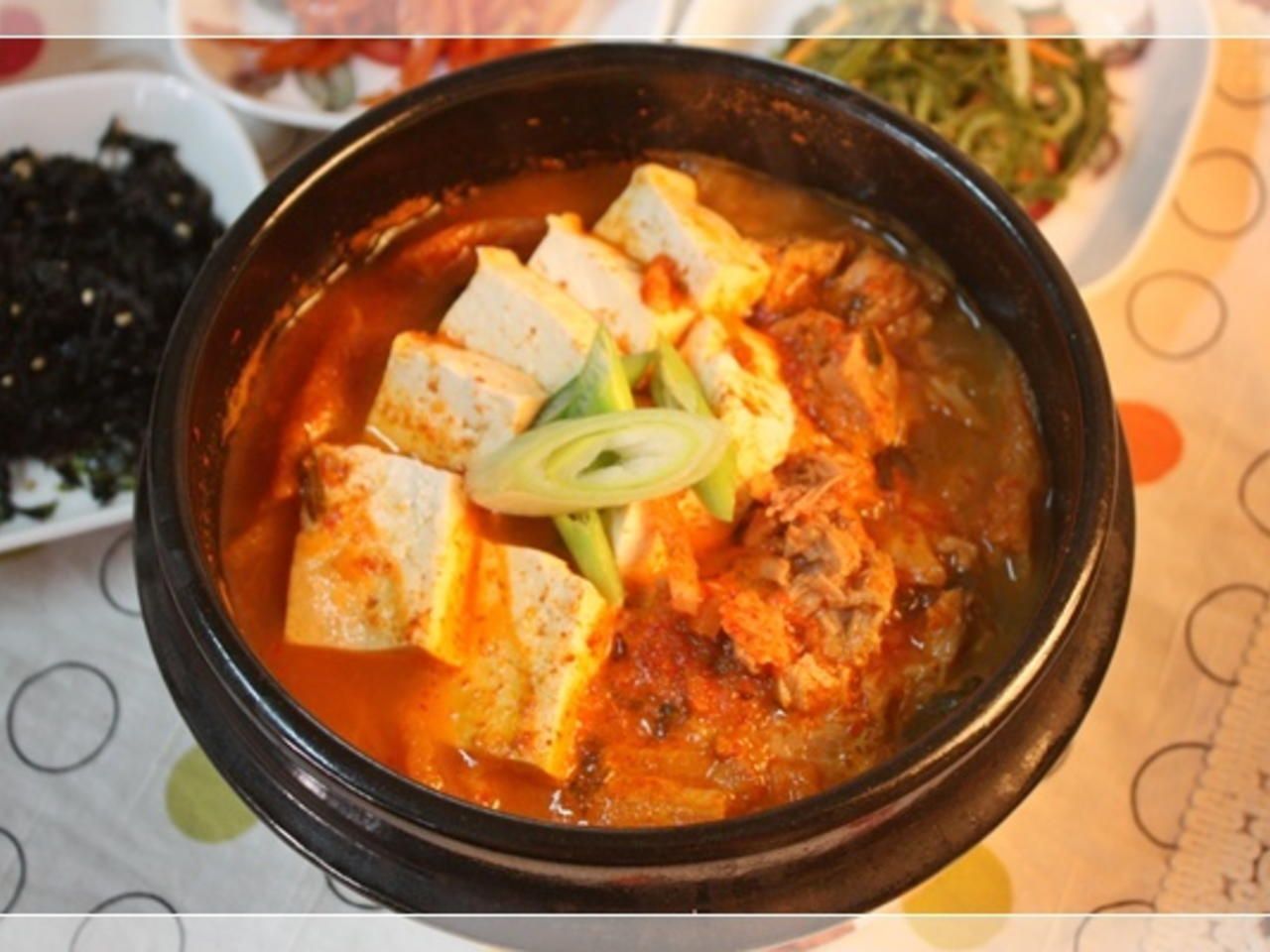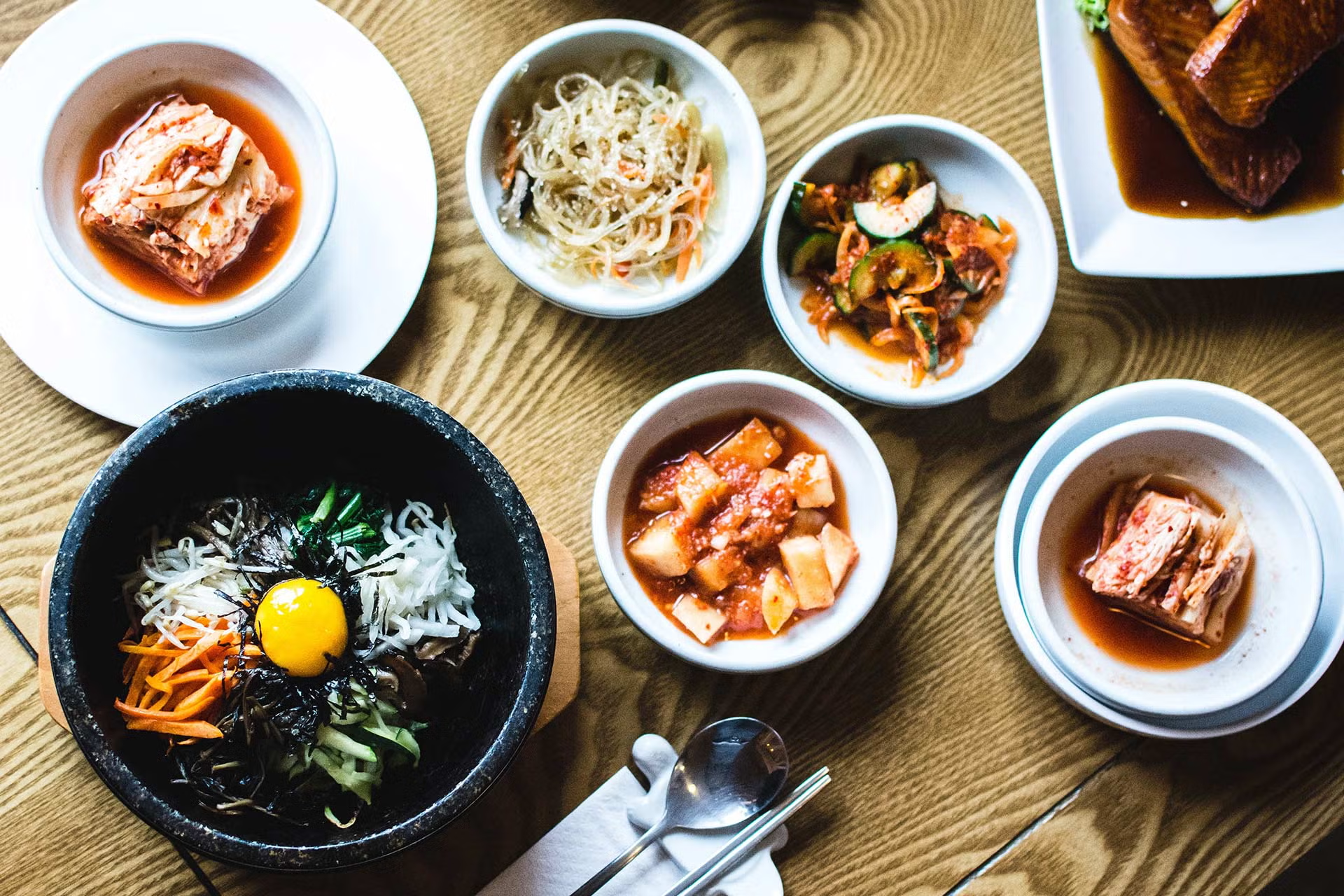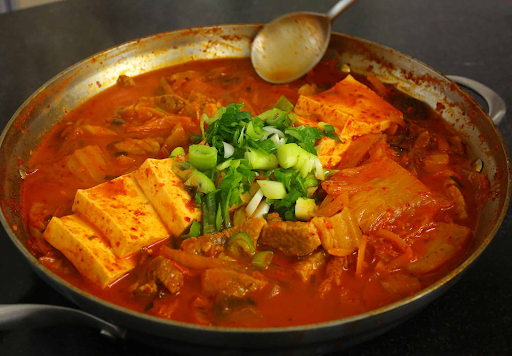How to Store Kimchi for Maximum Freshness | Miami Kimchi Guide
Kimchi is not only a delicious fermented food but also a powerhouse of probiotics and nutritional benefits. Whether you’re a long-time kimchi enthusiast or just starting your journey into this flavorful world, knowing how to store kimchi properly is essential. For those interested in authentic, handcrafted kimchi, you can always explore the offerings at Miami Kimchi. In this comprehensive guide, we’ll walk you through everything from shelf life and fermentation stages to the best storage methods and tips for preserving texture and probiotic power.
Understanding Kimchi Fermentation and Shelf Life
Kimchi is a living food—its flavor, texture, and nutritional properties evolve over time. In this section, we dive into the science behind kimchi fermentation and how understanding its shelf life can help you decide the best time to enjoy it.
What is Kimchi?
Kimchi is a traditional Korean side dish made primarily from fermented vegetables, most commonly napa cabbage and radishes, mixed with spices and seasonings. It undergoes lactic acid fermentation, which not only imparts a tangy, complex flavor but also builds up its probiotic content. This natural process means that kimchi keeps evolving the longer it is stored.
- Key Ingredients: Napa cabbage, radishes, garlic, ginger, chili flakes, and salt.
- Cultural Heritage: Kimchi is an integral part of Korean cuisine, celebrated for its robust flavors and health benefits.
- Probiotic Rich: The fermentation process increases beneficial bacteria, supporting gut health.
The Science Behind Kimchi Fermentation
Kimchi fermentation is a process that combines bacteria, primarily of the lactic acid variety, with vegetables and spices under certain conditions. This leads to their transformation into a product rich in taste, aroma, and health properties. The fundamental process of fermentation is quite simple and involves three stages:
- Preparation: Firstly, the fresh vegetables are washed and seasoned with spices.
- Fermentation: The vegetables are then left to ferment at room temperature. During this stage, the lactic acid bacteria thrive and multiply, creating an acidic environment that helps to preserve the cabbage and enhances its flavor.
- Maturation: Once optimal fermentation is achieved, kimchi is refrigerated to slow down the fermentation rate and allow the flavor to mellow and mature.
Shelf Life of Kimchi
How long kimchi lasts depends on various factors. Consumed fresh, it can be stored in the fridge for up to three months without a noticeable change in flavor. However, as a fermented product, it's safe to eat for even longer. The actual shelf life of kimchi can certainly extend past the six-month mark, oftentimes up to one or two years.
How to Determine If Kimchi Is Still Good to Eat?
Some signs that your kimchi is still good to enjoy include its vibrant color, acidic tangy smell, and if it's stored in a cold, overwhelmed with gases environment. A change in color, mold, or an off smell are all signs the kimchi might not be safe to consume.
Nutrition Facts per 100g Raw Kimchi
| Nutrient | Quantity |
|---|---|
| Calories | 15 |
| Protein | 1.1g |
| Fat | 0.5g |
| Carbohydrates | 2.4g |
| Fiber | 1.6g |
| Sugar | 1.1g |
Note: The nutritional content of kimchi may vary depending on the ingredients used and the duration of fermentation.
Shelf Life of Kimchi: Fresh, Aged, and Over-Fermented
Kimchi, a traditional Korean side dish, is known for its dynamic flavor profile and health benefits provided by its fermentation process. The shelf life of kimchi differs depending on storage conditions, fermentation level, and personal preference in taste. Here’s a detailed overview:
- Fresh Kimchi:
- Timeline: Fresh kimchi is optimal within The first 7-14 days of its preparation.
- Flavor & Texture: This variation provides a crisp, mildly tangy flavor, perfect for those who appreciate a fresh, crunchy condiment or side dish.
- Signature Dishes: Fresh kimchi works excellently as a refreshing side salad, in sandwiches, or as a crunchy topping for dishes like tacos or burgers.
- Aged Kimchi:
- Timeline: Aged kimchi, also known as mature kimchi, fully develops its flavor after 3-4 weeks.
- Flavor & Texture: It becomes deeper in taste and tanginess, with a softer texture. This is an ideal stage for adding complex flavors to Korean dishes.
- Signature Dishes: Particularly exceptional in traditional dishes like kimchi jjigae (kimchi stew) and as a flavorful accompaniment to rice dishes.
- Over-Fermented Kimchi:
- Timeline: Beyond 6 months, kimchi enters the over-fermented stage where it can be incredibly sour.
- Usage: While direct consumption at this stage may be too strong for some, it serves as a powerful ingredient in several recipes, bringing out the best in dishes like kimchi fried rice or soups.
- Signature Dishes: Its unique flavor profile excels in dishes such as kimchi pancakes, dumpling fillings, and braises.
Each phase of fermentation showcases unique qualities, making kimchi a versatile ingredient in a variety of dishes. Monitoring the storage environment is of utmost importance to ensure that kimchi remains at your desired stage of fermentation and offers the best taste and nutritional value.
The Science Behind Fermentation and Probiotic Benefits
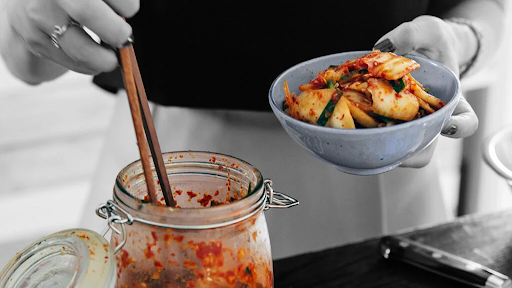
The fermentation process of kimchi is driven by lactic acid bacteria (LAB). Understanding the science behind this not only helps explain the transformation process but also sheds light on why kimchi is widely acclaimed for its health-promoting benefits.
- Lactic Acid Bacteria (LAB): These bacteria initiate the fermentation process by converting sugars present in the vegetables into lactic acid. This acid creates a suitable environment that not only preserves the kimchi but also encourages the growth of beneficial bacteria.
- Temperature Influence: Fermentation can be controlled by adjusting the storage temperature.
- Room Temperature: At room temperature, fermentation accelerates, resulting in a faster development of the sour taste characteristic of kimchi.
- Refrigeration: Refrigeration slows down the fermentation process, thereby extending the shelf life of kimchi and preserving its intended flavor and texture.
- Note: According to a study, the optimal temperature for fermentation is 15°C (59°F) for about two weeks.
- Probiotic Benefits: The fermentation process of kimchi results in a high probiotic content, which provides several health benefits.
- Gut Health: Regular consumption of kimchi can support a healthy gut due to the abundance of beneficial bacteria. It may also help alleviate symptoms of bowel disorders.
- Immune Support: Fermented foods like kimchi have been found to contribute to overall immune function, with studies indicating a 20% reduction in the duration of colds in adults consuming probiotics regularly.
- Cholesterol Reduction: Some research suggests that eating kimchi regularly can lower LDL (bad) cholesterol levels.
Armed with this fundamental understanding, you can effectively manage the storage and use of kimchi to maintain a balance between freshness, flavor, and associated health benefits. Whether you are a fan of the fresh crunch or the hearty tang of aged goodness, kimchi has something for everyone.
Best Storage Methods for Kimchi
How you store your kimchi plays a critical role in preserving its flavor, texture, and probiotic benefits. This section covers the most effective methods, weighing the pros and cons of refrigeration versus room temperature storage, and even exploring freezing options.
Storing Kimchi in the Refrigerator (The Recommended Method)
For most home kitchens, refrigeration is the optimal storage method. Here’s why:
- Temperature Control:
- Ideal Range: Store kimchi at 32–39°F to slow down fermentation without stopping it completely.
- Benefits: This temperature range ensures a balance where the kimchi maintains its crunch while gradually developing richer flavors.
- Container Choice:
- Best Options: Use glass jars or BPA-free plastic containers with airtight lids.
- Brine Protection: Keeping the kimchi fully submerged in its brine minimizes air exposure, which can lead to mold or off-flavors.
- Usage Tips:
- Minimize Air Exposure: Avoid opening the container too frequently. Each time the lid is opened, oxygen is introduced, speeding up fermentation.
- Labeling: Always label your container with the date of storage to track its aging process.
Step-by-Step Instruction:
- Preparation: After making your kimchi, ensure all pieces are evenly distributed and completely covered by the brine.
- Sealing: Use a clean utensil to press the kimchi down before sealing the container.
- Storing: Place the container in the refrigerator immediately and store it on a middle or lower shelf where the temperature is consistent.
Storing Kimchi at Room Temperature: When Is It Appropriate?
While refrigeration is ideal for long-term storage, there are occasions where room temperature storage can be acceptable—albeit only for short periods.
- Short-Term Storage:
- Duration: Room temperature storage is generally safe for up to 3 days.
- Considerations: The fermentation process speeds up at room temperature, meaning the flavor will evolve rapidly. This method is best for quick consumption or when you desire a more tangy, robust taste.
- Risks of Prolonged Room Temperature Storage:
- Over-Fermentation: Extended exposure can cause kimchi to become overly sour, sometimes even developing off-flavors.
- Safety: Ensure the storage area is clean, cool, and away from direct sunlight to prevent spoilage.
- Usage Scenario:
- If you’re hosting a meal and want a batch of quickly fermented, intensely flavored kimchi, room temperature storage might be a fun experiment—but always transfer leftovers back to the refrigerator.
Freezing Kimchi: Pros, Cons, and Considerations
When you find yourself with surplus kimchi, freezing becomes a viable option especially if you don't plan on consuming it promptly. Yet, as with many food preservation methods, freezing does have its own set of advantages and disadvantages.
Understanding these can help you decide if this method is suitable for your kimchi preservation needs, and if so, how to best go about it for optimal results.
Benefits of Freezing
- Halted Fermentation: Kimchi is a fermented food, and freezing effectively pauses this fermentation process. This means that the unique flavor that your kimchi has developed up to the point of freezing will essentially be locked in, preventing further changes.
- Extended Shelf Life: Fresh kimchi can typically last about a month in the fridge. However, freezing extends this considerably - up to a significant 3 to 6 months or longer, depending on your freezer's temperature and the packaging method used.
Drawbacks of Freezing
- Texture Changes: One of the characteristics of kimchi that fans love is its crispness. Unfortunately, freezing can change this texture, often making it softer post-thawing.
- Reduced Probiotic Activity: Kimchi is a fantastic source of probiotics, but freezing might reduce these active cultures. While some survive the freezing-thawing process, a percentage drop is commonly recorded, decreasing the potential health benefits.
Freezing Best Practices
- Portion Control: Freeze kimchi in manageable, single-use portions. This allows you to thaw only what you need per meal, maintaining the integrity of the remaining frozen batch.
- Storage Method: Choose freezer-safe containers or bags, ensuring as much air as possible is expelled before sealing to reduce the risk of freezer burn. If available, vacuum seal bags may provide the best results.
Additional Considerations
When freezing kimchi, it's crucial to remember the importance of freezing it as fresh as possible. The fresher the kimchi is when frozen, the better the quality when thawed. A general rule of thumb is to freeze on the day of purchase or soon after.
Summary Table
| Aspect | Pros | Cons |
|---|---|---|
| Fermentation | Stops further fermentation preserving flavor profiles. | None |
| Shelf Life | Extends shelf life significantly. | None |
| Texture | None | Changes texture causing softness post thawing. |
| Probiotic Activity | None | Reduces cultured activity. |
Step-by-Step Guide for Storing Kimchi
This section provides detailed, step-by-step instructions to help you store kimchi correctly. Whether you’re a beginner or an experienced fermenter, these steps—supported by high-quality visuals—will guide you through the process.
Step 1: Preparing Your Kimchi for Storage
Before storage, it’s important to ensure your kimchi is properly prepared. Follow these steps:
- Clean Work Area:
- Ensure all surfaces and utensils are sanitized. This reduces the risk of contamination.
- Even Distribution:
- Mix your kimchi well so that the seasoning and brine are evenly distributed among the vegetables.
- Visual Tip:
- Insert a high-quality visual here showing a clean kitchen workspace with all necessary utensils arranged neatly.
Step 2: Choosing the Right Container
The container you select can make a huge difference in the longevity and quality of your kimchi.
- Container Options:
- Glass Jars: Best for non-reactivity and maintaining flavor integrity.
- BPA-Free Plastic Containers: Lightweight and durable alternatives.
- Vacuum-Sealed Bags: Excellent for minimizing air exposure.
- Guidelines:
- Choose a container that is large enough to hold your kimchi without excessive empty space, which can lead to oxidation.
- Visual Tip:
- Insert an image of various container types, highlighting the pros and cons of each option.
Step 3: Proper Sealing and Labeling
Correct sealing and labeling are crucial steps to ensure that your kimchi remains fresh and trackable.
- Sealing:
- Press the kimchi down firmly so that it is completely submerged in its brine. This minimizes oxygen exposure.
- Use a tight-fitting lid to prevent air from entering the container.
- Labeling:
- Write the date of storage on a label and attach it to the container. This helps you monitor the fermentation progress.
- Visual Tip:
- Include a step-by-step image showing how to press down the kimchi, seal the jar, and apply a label with the storage date.
Step 4: Storing in the Correct Environment
Once your kimchi is prepared and sealed, the final step is placing it in the proper storage environment.
- Refrigeration:
- Place the kimchi in the refrigerator at a stable temperature (32–39°F).
- Avoid storing on the door, as temperature fluctuations may affect fermentation.
- Room Temperature (Short-Term):
- If you’re storing kimchi at room temperature for a short duration (up to 3 days), place it in a cool, dark place away from direct sunlight.
- Monitoring:
- Check your kimchi periodically. Notice any changes in aroma or texture, and decide if it’s ready for consumption or if it needs to be moved to the refrigerator.
- Visual Tip:
- Insert a diagram that illustrates proper placement in a refrigerator versus room temperature storage, emphasizing temperature zones.
Pro Tips for Maintaining Kimchi’s Freshness, Texture, and Probiotic Benefits
Maximizing the benefits of kimchi involves careful handling and proactive maintenance. Here are some expert tips to ensure your kimchi stays flavorful and nutritious:
Choosing the Right Container
- Glass Jars:
- They are non-reactive, which means they won’t alter the flavor of your kimchi.
- BPA-Free Plastics:
- Durable and lightweight, these containers are a great alternative if you prefer plastic.
- Vacuum-Sealed Options:
- These minimize oxygen exposure and can extend the shelf life of your kimchi.
Handling Kimchi with Care
- Use Clean Utensils:
- Always use a clean spoon or fork when serving to avoid contaminating the jar.
- Keep It Submerged:
- Ensure the kimchi remains fully covered by its brine to prevent exposure to air.
- Limit Exposure:
- Try to minimize the frequency of opening the container. The fewer the disturbances, the more stable the fermentation process.
- Monitor Temperature:
- A consistent storage temperature will help maintain the ideal fermentation rate.
Additional Daily Tips
- Label and Date:
- Keeping track of when your kimchi was stored helps you determine the best time to consume it.
- Adjust Seasonings if Needed:
- If you notice the flavor shifting too quickly, consider adding fresh vegetables or spices to balance it.
- Visual Aid:
- Insert a tip sheet image with bullet points summarizing the best practices for daily kimchi care.
Discover Your Nearest Korean/Asian Grocery Store
If you're searching for top-quality, authentic Korean and Asian ingredients, we're delighted to share our four USA locations. Each store has a broad range of fresh foods, including kimchi and other fermented favorites that showcase tradition and quality.
- Miami, FL:
Experience a diverse selection of handcrafted kimchi varieties in a lively setting. - Pembroke Pines, FL:
Explore an array of flavors designed to please your palate. - Hollywood, FL:
Come to our Hollywood branch for top-notch, traditionally made kimchi. - Coral Springs, FL:
Visit us for an outstanding choice of kimchi and other fermented specialties.
Each location boasts knowledgeable staff who are passionate about ensuring you receive both quality products and expert advice on storage and consumption.
Final Thoughts on Storing Kimchi for Maximum Freshness
Proper storage is the key to enjoying kimchi at its best—balancing the evolution of flavor with the preservation of texture and probiotic benefits. Whether you enjoy your kimchi fresh or prefer it well-aged with a tangy kick, understanding the right storage methods can enhance your overall experience.
- Refrigeration is ideal: It offers precise temperature control that slows fermentation while keeping your kimchi crisp.
- Room temperature storage: Useful for short-term needs but requires careful monitoring.
- Freezing: A viable option for long-term storage, though it may change the texture slightly.
By following these expert tips and step-by-step instructions, you can ensure that your kimchi remains delicious, nutritious, and full of flavor every time you open the jar. Remember, a well-maintained batch of kimchi not only satisfies your taste buds but also contributes to your overall health with its natural probiotic benefits.
For more detailed guides, recipes, and expert advice, be sure to explore additional resources and visit Miami Kimchi. Whether you’re looking to improve your own kimchi storage techniques or find premium kimchi at one of our USA locations, we are here to support your journey into the world of fermented foods.
Frequently Asked Questions About Storing Kimchi
What is the ideal storage temperature for kimchi?
For best results, store kimchi in the refrigerator at temperatures between 32°F and 39°F. This temperature range slows down fermentation while preserving texture and flavor.
How long can I keep kimchi in the refrigerator?
- Fresh Kimchi: Enjoy within 7–14 days for a crisp and mildly tangy flavor.
- Aged Kimchi: It can be stored for 3–4 weeks if you prefer a richer, more complex taste.
- Extended Storage: With proper refrigeration, kimchi can last up to 3–6 months, though it may become more sour over time.
Is it safe to store kimchi at room temperature?
Room temperature storage is only safe for very short periods (up to 3 days). Beyond that, the fermentation accelerates rapidly, which can lead to over-fermentation and potential spoilage.
Can I freeze kimchi for long-term storage?
Yes, you can freeze kimchi to halt further fermentation. However, freezing may alter its texture and reduce some probiotic benefits. It is best frozen in small portions for single-use servings.
How do I know when my kimchi is over-fermented?
Over-fermented kimchi will have a very sour taste, a softer texture, and a stronger aroma. While it may still be safe to eat, it might not have the desired flavor and crunch you expect from fresh kimchi.
What steps can I take to maintain the probiotic benefits of kimchi?
- Refrigeration: Keep your kimchi in the refrigerator to slow down fermentation.
- Proper Sealing: Ensure that your kimchi is tightly sealed and fully submerged in its brine.
- Avoid Frequent Disturbance: Minimize opening the container to preserve the beneficial bacteria.

